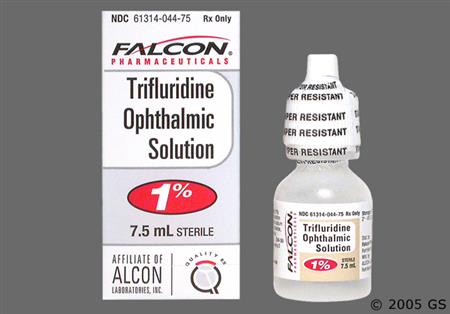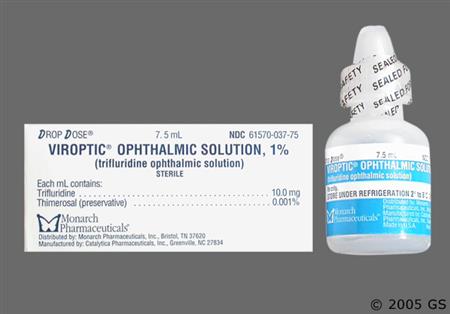ThisiscontentfromElsevier'sDrugInformation
Trifluridine
Learn more about Elsevier's Drug Information today! Get the drug data and decision support you need, including TRUE Daily Updates™ including every day including weekends and holidays.
1 drop in the affected eye(s) every 2 hours while awake up to 9 drops/day until the corneal ulcer has completely re-epithelialized, then 1 drop in the affected eye(s) every 4 hours while awake for a minimum of 5 drops/day for 7 days. Consider other forms of therapy if there are no signs of improvement after 7 days of therapy or complete re-epithelization has not occurred after 14 days of therapy. Avoid continuous administration for periods exceeding 21 days due to the potential for ocular toxicity.[32394]
1 drop in the affected eye(s) every 2 hours while awake up to 9 drops/day until the corneal ulcer has completely re-epithelialized, then 1 drop in the affected eye(s) every 4 hours while awake for a minimum of 5 drops/day for 7 days. Consider other forms of therapy if there are no signs of improvement after 7 days of therapy or complete re-epithelization has not occurred after 14 days of therapy. Avoid continuous administration for periods exceeding 21 days due to the potential for ocular toxicity.[32394]
1 drop in the affected eye(s) every 2 to 4 hours (Max: 9 drops/day) for 7 to 14 days.[32396] [68041] [68042] [68043]
1 drop in the affected eye(s) every 2 to 4 hours (Max: 9 drops/day) for 7 to 14 days.[32396] [68041] [68042] [68043]
1 drop in the affected eye(s) every 2 hours (Max: 9 drops/day) until reepithelialization or for 2 weeks, then 1 drop in the affected eye(s) every 4 hours (Min: 5 drops/day) for 7 days or 1 drop in the affected eye(s) four times daily for 2 weeks. Continue treatment until all periocular lesions have healed. Max duration: 21 to 28 days. Use in consultation with an ophthalmologist.[34362] [68039] [68040] [70312]
1 drop in the affected eye(s) every 2 hours (Max: 9 drops/day) until reepithelialization or for 2 weeks, then 1 drop in the affected eye(s) every 4 hours (Min: 5 drops/day) for 7 days or 1 drop in the affected eye(s) four times daily for 2 weeks. Continue treatment until all periocular lesions have healed. Max duration: 21 to 28 days. Use in consultation with an ophthalmologist.[34362] [68039] [68040] [70312]
1 drop in the affected eye(s) every 2 hours (Max: 9 drops/day) until reepithelialization or for 2 weeks, then 1 drop in the affected eye(s) every 4 hours (Min: 5 drops/day) for 7 days or 1 drop in the affected eye(s) four times daily for 2 weeks. Continue treatment until all periocular lesions have healed. Max duration: 21 to 28 days. Use in consultation with an ophthalmologist.[68039] [68040] [70312]
Apply 1% topical trifluridine 3-times daily for at least 21 to 28 days as an alternative.[34362]
Apply 1% topical trifluridine 3-times daily for at least 21 to 28 days as an alternative.[34362]
9 drops/day to affected eye(s).
9 drops/day to affected eye(s).
9 drops/day to affected eye(s).
> = 6 years: 9 drops/day to affected eye(s).
< 6 years: Safety and efficacy have not been established.
Specific guidelines for dosage adjustments in hepatic impairment are not available; it appears that no dosage adjustments are needed.
Specific guidelines for dosage adjustments in renal impairment are not available; it appears that no dosage adjustments are needed.
† Off-label indication


Trifluridine (also known as trifluorothymidine) is an ophthalmic antiviral preparation indicated for primary keratoconjunctivitis and recurrent epithelial keratitis due to herpes simplex virus (HSV) types 1 and 2. Trifluridine is the treatment of choice for this indication and therapy is associated with a cure rate greater than 90%. HSV infections resistant to idoxuridine and/or vidarabine are effectively treated with trifluridine without cross-toxicity or allergenicity. Additionally, trifluridine shows in vitro and in vivo activity against vaccinia virus and in vitro inhibition of some strains of adenovirus.[32399] Off-label use of topical ophthalmic trifluridine can be considered for treatment of vaccinia infection of the conjunctiva or cornea associated with smallpox vaccination.[32396] Prophylactic therapy with trifluridine may also be considered to prevent spread to the conjunctiva and cornea if vaccinia lesions are present on the eyelid or near the eye.[31173] Trifluorothymidine was first developed as an antitumor agent and was later found to inhibit HSV in vitro. Compared to other systemic agents, it displayed low selectivity and high toxicity and, thus, was not developed for systemic use.[32427] This drug was approved by the FDA as a topical 1% ophthalmic solution in April 1980.
For storage information, see the specific product information within the How Supplied section.
Hazardous Drugs Classification
The most frequent adverse reactions reported in clinical trials of trifluridine were mild, transient ocular irritation (burning and stinging) upon instillation (4.6%) and palpebral edema (blepharedema, 2.8%). Other reported adverse reactions included superficial punctuate or epithelial keratopathy, hypersensitivity reaction, stromal/corneal edema, keratitis sicca, hyperemia, and ocular hypertension.[32394]
Trifluridine has been reported to cause an allergic contact dermatitis in patients receiving the ophthalmic solution to treat herpetic keratitis. One patient presented with a history of 3 months of eczema of the eyelids after applying trifluridine eye drops.[32397] The second patient experienced a serious dermatitis around the right eye, which spread within a few days to the whole face, trunk, and proximal parts of the extremities following one week of treatment with 1% trifluridine eyedrops.[32398] Patch testing was used to confirm the cause of the allergic reaction; in both cases trifluridine and not the solution components was associated with the adverse response.
The coadministration of certain medications may lead to harm and require avoidance or therapy modification; review all drug interactions prior to concomitant use of other medications.
This medication is contraindicated in patients with a history of hypersensitivity to it or any of its components.
Continuous administration of trifluridine for periods exceeding 21 days should be avoided because of potential ocular toxicity.[32394] Punctate lesions in the corneal epithelium are clinical manifestations of trifluridine cytotoxicity. Upon discontinuation, toxic changes to the surface of the eye are generally reversible.[32396]
Use trifluridine during pregnancy only if the potential benefit justifies the potential risk to the fetus. There are no adequate and well-controlled studies during human pregnancy. In animal studies, no teratogenic or fetotoxic effects were observed in rabbits after ophthalmic administration of doses approximately 5 times the estimated human exposure. However, offspring of rats and rabbits receiving subcutaneous doses of 2.5 to 5 mg/kg/day (11.5 to 23 times the estimated human exposure) experienced toxicities that included delayed ossification, fetal death, and resorption.[32394]
Use trifluridine with caution during breast-feeding. However, trifluridine is not likely to be excreted in human milk after ophthalmic administration due to its relatively small dosage, its dilution in body fluids, and its extremely short half-life.[32394]
Trifluridine is structurally similar to thymidine and, therefore, inhibits thymidine incorporation into replicating viral DNA. Trifluridine is a fluorinated pyrimidine nucleoside which irreversibly inhibits thymidylate synthase and specific DNA polymerases, necessary for the conversion of dUMP to dTMP in the process of DNA synthesis.[32426] In cultured mammalian cells, trifluridine is incorporated in place of thymidine into viral DNA, resulting in faulty DNA and the inability to reproduce or to infect or destroy tissue.[32394] To a lesser extent, trifluridine is also incorporated into cellular DNA and is capable of decreasing DNA synthesis in both infected and uninfected cells.[32427] Viral resistance to trifluridine is rare.
Revision Date: 08/15/2025, 07:59:58 AMTrifluridine is applied topically to the eye as a solution. The half-life of trifluridine is approximately 12 minutes. Frequent application is necessary in order to inhibit multiplication of the susceptible virus.[32394]
Ophthalmic Route
Following ophthalmic application, intraocular penetration is adequate. Decreased corneal integrity or stromal or uveal inflammation may enhance the penetration of trifluridine into the aqueous humor. The major metabolite of trifluridine, 5-carboxy-2'-deoxyuridine, is not found in detectable concentrations within the aqueous humor of the human eye. Trifluridine systemic absorption is negligible following therapeutic dosing. No detectable concentrations of trifluridine or 5-carboxy-2'-deoxyuridine are found in the sera of normal healthy adults upon completion of a 14-day regimen using the product seven times daily.
Use trifluridine during pregnancy only if the potential benefit justifies the potential risk to the fetus. There are no adequate and well-controlled studies during human pregnancy. In animal studies, no teratogenic or fetotoxic effects were observed in rabbits after ophthalmic administration of doses approximately 5 times the estimated human exposure. However, offspring of rats and rabbits receiving subcutaneous doses of 2.5 to 5 mg/kg/day (11.5 to 23 times the estimated human exposure) experienced toxicities that included delayed ossification, fetal death, and resorption.[32394]
Use trifluridine with caution during breast-feeding. However, trifluridine is not likely to be excreted in human milk after ophthalmic administration due to its relatively small dosage, its dilution in body fluids, and its extremely short half-life.[32394]
Cookies are used by this site. To decline or learn more, visit our cookie notice.
Copyright © 2025 Elsevier, its licensors, and contributors. All rights are reserved, including those for text and data mining, AI training, and similar technologies.